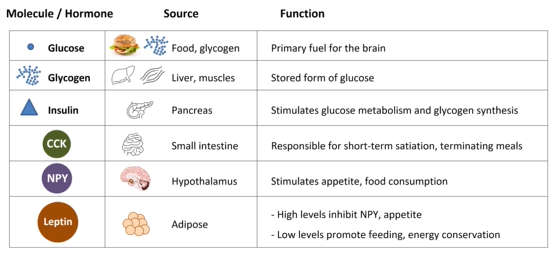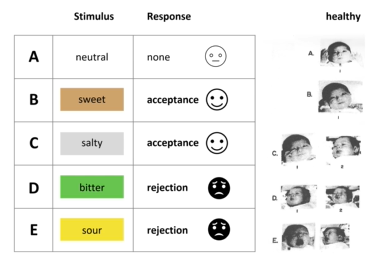Hunger / Chemical Senses
1/21
There's no tags or description
Looks like no tags are added yet.
Name | Mastery | Learn | Test | Matching | Spaced |
|---|
No study sessions yet.
22 Terms
Blood Glucose
Low levels allow you to feel hungry
Keeps body functions operational (preffered source of fuel)
Your body stores glycogen to regulate blood glucose levels
Stored in muscles/liver
When levels decrease, liver breaks down glycogen as glucose to put into blood
As glycogen reserves deplete, a signal of hunger gets sent to brain
Insulin
Mediates glucose/glycogen balance
Made in pancreas
Promotes uptake of glucose by cells for immediate use/storage
NPY
Drives hunger
Drives high level of activity in hypothalamus associated with increases appetite and food-seeking behaviour
Brain Signals: Satiety
Stomach Stretch Receptors
Stretch receptors in the stomach activated as it fills
the vagus nerve connects to the gut and brain transferring that signal
Gastrointestinal Hormones
Digestive hormones in the gastrointestinal tract send signals of satiety
Liver:
Liver sends brain signals to trigger hunger/satiety
It moniters glucose stores and blood-sugar levels to regulate hunger
If you inject a dog with glucose in a vein leading to the liver, it stops eating
If you inject glucose in any other vein, it will keep eating
low glucose = low glycogen = hunger
CCK
Produced in the small intestine
Brain receptors detect this and serves as signal to stop eating
It’s a short-term signal for ending a meal
Long-term Energy Storage
Fat is the ideal form instead of glycogen
It contains twice the energy density and can be found anywhere on the body
Leptin
Secreted by the adipose tissue
Involved in longterm energy balance correlating with fat mass
They act on hypthalamus receptors to reduce appetite and feeding
It’s production is controlled by the OB gene
Mice lacking OB gene = no leptin = fat mouse
When humans are given high enough amount of leptin, they become leptin resistant
Evolutionary Leptin Role
The primary adaptive function of leptin was to serve as an indicator of low energy stores
instead of reducing food intake
Low leptin = more foraging effort OR minimize activity to conserve energy
It was rare for people to have high leptin/adipose tissue back then bc harder to get food
Leptin/NPY
Leptin acts to inhibit the actions of NPY
The mediated increase of NPY is prevented by leptin to decrease appetite and energy consumption
They interact to regulate your weight to optimal levels
NPY and Carbs Consumption
NPYurgic neurons can affect reward driven feeding for high calorie foods
Experiment:
Satieted rats were injected with NPY in the brain
Results:
Increased intake of sucrose
They worked harder for a cue associated with sucrose
They increased saccharine consumption
They chose carbs over protein or fat diet
NPY action promoted conditional/unconditional behaviours leading to inc carb consumption
Endogenous Opioids
Naturally occuring chemical substance with morphine-like analgesic actions in the body
Contributes to palatability and reward-driven feeding
Naloxone reduces intake of saccharin, sucrose and saline
Proof: Mice who lack the opioid receptors have lower preference for saccharin and control mice
Overeating in people may be reflective of a maladative opioid mediated reward driven feeding mechanism
Overeating may be caused by a dysfunctional reward system in the brain, driven by opioids.
Weight Regulating Hormones/Molecules Summary

Taste
Indication of nutritional quality
Bitter/Sour: Poison
This skill is innate as all babies have the same response to those foods
It’s an adaptive mechanism as it’s controlled by lower regions of the brain
Umami: Amino Acids (Glutamate and Aspartate)
Salty: Electrolytes
Sweet: Glucose

Personal Taste Sensitivity
Foods you enjoy as an adult is learned by experience
High sensitive tasters have more taste buds on average
Females usually are more sensitive to sweet and bitter
Increases during pregnancy first trimester which is when the fetus is most sensitive to toxins
Detecting Taste
Taste buds have 50-150 taste receptor cells
2/3 of taste buds are your tongue while the rest are on the soft palate and throat opening
Taste receptors fire an action potential sent from the main gustatory nerve to the medulla in the brain stem
Info may act locally in response, ex. gagging even before being aware
Info goes from medulla to thalamus and then to several higher brain regions
Ex. Gustatory Cortex
Gustatory Cortex
Lets you percieve taste with specific neurons responding to each of the five basic tastes
Connects with many other brain areas, combining taste with other info
Primary somatosensory cortex combines taste with feel and texture
Orbital Cortex combines taste with small info to provide flavour

Smell in Flavour/Tasting
Taste receptors detect sweetness and categorize the sublte differences broadly under “sweet”
Small allows you to detect flavour when it interacts with taste in the nasal pharynx
Spice
Not a taste
Results from capsasin binding to heat and pain receptors in the mouth
Causes action potentials to fire, making you feel pain
Human Smell Mechanism
Has direct link to the cortex without going through thalamus
It’s important for alerting you of specific env changes/events
Airborne molecules can communicate info from long distances
Molecules enter the nasal cavity and dissolve in the mucus
they interact with the Olfactory cilia, where 10-20 of them give input to one olfactory receptor cell
A specific smell activates a unique pattern of firing across multiple receptos allowing you to detect a large range of stimuli
Summary:
Odourants bind to receptors
Olfactory receptors are activated and send signals to the olfactory bulb
Signals relayed in the glomeruli recieving input from thousands of olfactory receptors
The signals are transmitted to higher brain regions
Higher Brain Area Processing of Smell
Signal goes from glomeruli to:
hypothalamus
areas of the limbic system
primary olfactory cortex in the temporal lobe
secondary olfactory cortex in frontal lobe
Short-term/Long-term
Shorterm:
Hunger regulated by glucose/glycogen levels
Hunger regulated by CCK and NPY
Longterm:
Leptin regulated body weight through actions on NPY in hypothalamus